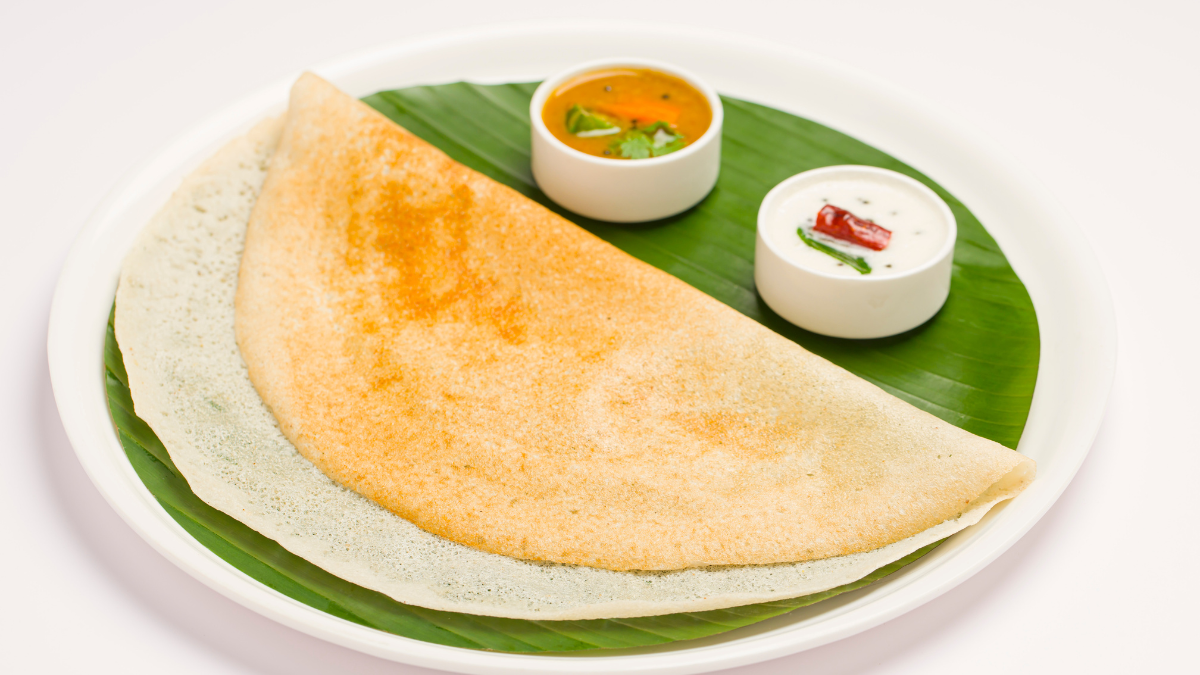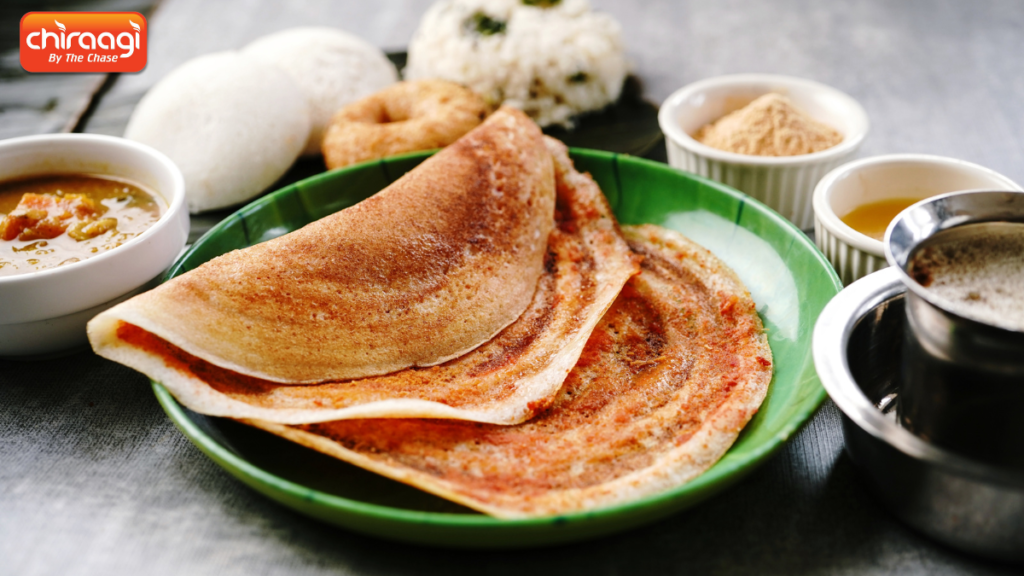A classic South Indian dish known for its delicious flavor and crispy texture is rava dosa. Rava Dosa is produced of semolina (also known as sooji), rice flour, and all-purpose flour, as opposed to traditional dosa, which is made with rice and urad dal. Because it doesn’t need to ferment, this instant dosa variation is a quick and easy choice for a hearty breakfast or a light meal.
Ingredients for Rava Dosa
The key to making the ideal Rava Dosa is combining components with great care.
Here’s what you’ll need:
- Semolina (Rava/Sooji): 1 cup
- Rice Flour: 1/2 cup
- All-Purpose Flour (Maida): 1/4 cup
- Yogurt (Curd): 1/4 cup
- Water: 2-3 cups (as needed for batter consistency)
- Green Chilies: 2, finely chopped
- Ginger: 1-inch piece, finely chopped
- Cumin Seeds (Jeera): 1 teaspoon
- Black Peppercorns: 1 teaspoon, crushed
- Coriander Leaves: A handful, finely chopped
- Salt: To taste
- Oil/Ghee: For cooking
Step-by-Step Preparation of Rava Dosa

1. Preparing the Batter
- Mixing Dry Ingredients: All-purpose flour, rice flour, and semolina should all be combined in a sizable mixing bowl.
- Adding Yogurt: Stir the yogurt into the concoction. Yogurt gives the dosa a little acidity and makes it crispier.
- Achieving the Right Consistency: Water should be added gradually to the mixture while being constantly stirred to prevent lumps. The batter should have a thin, creamy texture, similar to buttermilk.
- Spicing It Up: Mix the ginger, cumin seeds, crushed black peppercorns, finely chopped green chilies, and salt into the batter.
- Resting the Batter: Give the batter a good 20 to 30 minutes to rest. During this time of sitting, the semolina can absorb the water and swell, giving it the ideal texture.
2. Cooking the Rava Dosa
- Heating the Pan: Turn the heat up to medium-high on a nonstick dosa tawa (griddle). Before adding the batter, make sure the pan is hot.
- Pouring the Batter: Ladle a ladleful of batter onto the hot tawa, working your way inward from the sides. It should spread organically, unlike traditional dosa batter, thus avoiding using a ladle to spread the rava dosa batter.
- Adding Oil: Pour a spoonful of oil or ghee onto the dosa’s surface and around its edges.
- Cooking: Over medium-high heat, cook the dosa until the bottom becomes crispy and golden brown and the edges begin to lift.
- Flipping (Optional):To achieve a slightly less crispy dosa, turn it over and continue cooking for an additional minute. On the other hand, Rava Dosa is not typically flipped.
- Serving: Serve the hot dosa with sambar, coconut chutney, or tomato chutney.
Tips for Perfect Rava Dosa
- Consistency is Key: The batter needs to be extremely thin—almost buttermilk-like. To keep the batter the proper consistency while it cools, add a little water if it thickens.
- Hot Pan: Before adding the batter, make sure the tawa is hot enough. The dosa will stick to the surface of a cold pan.
- Even Spreading: For an even spread and lace-like look, pour the batter from a height.
- Resting Time: Give the batter at least twenty to thirty minutes to rest. For the semolina to absorb water and swell, this stage is essential.
Variations of Rava Dosa
1. Onion Rava Dosa
Ingredients:
- Finely chopped onions: 1/2 cup
- Chopped green chilies: 1-2
Preparation: Pour the batter onto the dosa and top with finely chopped onions and green chilies. A lovely crunch and sweetness are added to the dosa by the cooking and caramelization of the onions.
2. Masala Rava Dosa
Ingredients:
- Potato masala: Prepared with boiled potatoes, onions, and spices
Preparation: To fold the dosa over, place a prepared potato masala in the center of the pastry. This version gives the crunchy dosa a filling that is robust and savory.
3. Rava Dosa with Mixed Vegetables
Ingredients:
- Finely chopped vegetables (carrots, bell peppers, tomatoes): 1 cup
Preparation: Mix the vegetables into the batter with a fine chop. This gives the classic dosa a vibrant and wholesome touch.
Health Benefits of Rava Dosa
Rava Dosa is not just a delightful treat but also offers several health benefits:
- Rich in Carbohydrates: A fantastic source of carbohydrates, semolina gives you energy to start the day.
- Low in Fermentation: Because Rava Dosa doesn’t need to be fermented, people with sensitive stomachs may find it simpler to digest.
- Versatile and Nutritious: You can improve the dosa’s nutritional value by including veggies or other healthful ingredients.
Pairing Rava Dosa with Side Dishes
1. Coconut Chutney
Ingredients:
- Grated coconut: 1 cup
- Green chilies: 2-3
- Ginger: 1-inch piece
- Roasted chana dal: 2 tablespoons
- Salt: To taste
- Water: As needed
- Tempering: Mustard seeds, curry leaves, dry red chilies, and oil
Preparation: Grated coconut, ginger, green chilies, roasted chana dal, salt, and water should all be blended into a homogeneous mixture. Add mustard seeds, curry leaves, and dried red chilies to heated oil to temper.
2. Tomato Chutney
Ingredients:
- Tomatoes: 2 large, chopped
- Onions: 1 small, chopped
- Garlic: 2 cloves
- Red chilies: 2-3
- Tamarind: A small piece
- Salt: To taste
- Oil: 1 tablespoon
Preparation: Add the onions, garlic, and red chilies to oil and sauté until the onions become tender. Cook the tomatoes till they get soft after adding the tamarind. Add salt after blending to a smooth paste.
3. Sambar
Ingredients:
- Toor dal: 1/2 cup
- Mixed vegetables (carrots, beans, potatoes): 1 cup
- Tamarind: A small lemon-sized ball
- Sambar powder: 2 tablespoons
- Turmeric powder: 1/2 teaspoon
- Salt: To taste
- Tempering: Mustard seeds, curry leaves, dry red chilies, and oil
Preparation: Simmer the toor dal and veggies in turmeric powder till they are tender. Stir in salt, sambar powder, and tamarind pulp. Simmer for ten to fifteen minutes. Temper in hot oil with curry leaves, mustard seeds, and dried red chilies.
Conclusion
You may tailor the tasty, fast, and adaptable dosa recipe to your own taste and dietary requirements. It never ceases to impress, whether you prefer it plain, packed with masala, or with onions. You may learn how to make the ideal Rava Dosa at home if you use the appropriate components and methods.
Also Read:- Delicious and Nutritious Soft Food Recipes 2024


